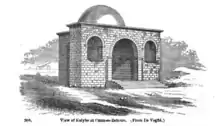Kalybe (temple)
A Kalybe (κάλὑβη) is a type of temple found in the Roman East dating from the first century and after. They were intended to serve as a "public facade or stage-setting, solely for the display of statuary." "[T]hey were essentially stage-sets for ritual enacted in front of them."[1] The kalybe has been associated with the Imperial Cult.

The first Kalybe to be identified as a distinct type was in Umm Iz Zetum, described by Eugène-Melchior de Vogüé in 1867. Together with the temple he found two greek inscriptions describing the structure as a "kalybe." Other than these, the only occurrence of the term is in a lexicon of Hesychius of Alexandria from the fifth century,[2] Since that time more than seven similar temples have been identified in Roman Syria. In addition to Umm Iz Zetum these include Shaqqa (Saccaea), Il-Haiyat, Shahba (Philippopolis) (built around 245 by the Emperor Philip the Arab), Qanawat (Kanatha), Bosra (Bostra),[2] and Amman (Philadelphia ).[1]
Kalybes were built facing a square or plaza where worshipers could gather. It is believed they were influenced by Nabatean designs. Possibly the oldest, at Bosra, was built in the late first century when Bosra was the capital of the Nabatean Kingdom under Rabbel II Soter. Their form most resembles the rock-cut temples at Petra,[1] and most have been found in cities that were formerly part of the Nabatean Kingdom.
References
- Ball, Warwick (2002). Rome in the East: The Transformation of an Empire. Routledge. p. 292. ISBN 978-0415243575. Retrieved 25 Oct 2020.
- Segal, Arthur (2001). "The "Kalybe Structures": Temples for the Imperial Cult in Hauran and Trachon" (PDF). Assaph: Studies in Art History.: 91–118. Retrieved Oct 26, 2020.